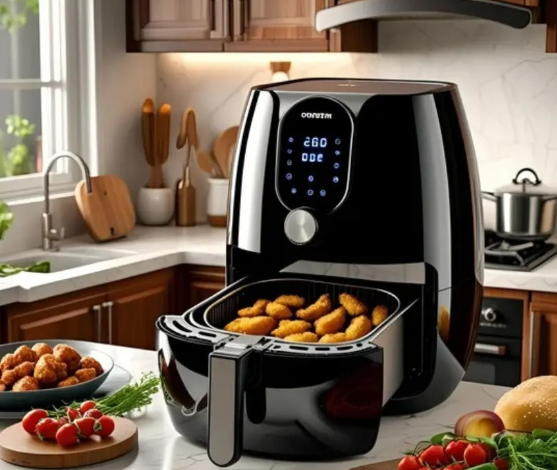Air Fryer Myths Busted: Separating Internet Hype from Kitchen Reality

Social media is flooded with air fryer content – from miracle transformation videos to dramatic before-and-after photos. But how much of what you see online is actually true? With millions of posts claiming everything from “tastes exactly like deep frying” to “cures all your cooking problems,” it’s no wonder people feel confused about what air fryers can really do.
The reality is that air fryers are genuinely useful appliances, but they’re not the magical cure-all that some influencers make them out to be. According to industry analysis from best-air-fryer.co.uk, which tracks over 1,800 models across 400+ brands, the gap between marketing claims and real-world performance is often significant.
So what’s actually true about air fryers, and what’s just clever marketing? Let’s dig into the most persistent myths and uncover the honest truth about what these appliances can and cannot do.
Table of Contents
| Sr# | Headings |
| 1 | The “Tastes Exactly Like Deep Frying” Myth |
| 2 | The “Completely Oil-Free Cooking” Misconception |
| 3 | The “Saves Tons of Money” Exaggeration |
| 4 | The “Cooks Everything Perfectly” Fantasy |
| 5 | The “Super Easy Cleanup” Half-Truth |
| 6 | The “Uses No Energy” Environmental Myth |
| 7 | The “Healthiest Cooking Method” Oversimplification |
| 8 | The “Faster Than Everything” Speed Claims |
| 9 | The “Silent Operation” Noise Myth |
| 10 | The “Perfect for Large Families” Capacity Reality |
| 11 | The “Works for All Diets” Universal Solution Myth |
| 12 | The “Never Burns Food” Safety Misconception |
| 13 | The “Replaces All Other Appliances” Versatility Hype |
| 14 | Setting Realistic Expectations for Success |
The “Tastes Exactly Like Deep Frying” Myth
This is probably the biggest misconception floating around social media, and it sets people up for disappointment from day one.
The Reality Check
Air-fried food does NOT taste exactly like deep-fried food. It’s crispy, it’s delicious, and it satisfies many of the same cravings – but it’s fundamentally different. Deep frying creates unique flavors and textures through oil saturation and specific chemical reactions that air frying simply cannot replicate.
What Air Frying Actually Achieves
Instead of trying to perfectly mimic deep frying, air frying creates its own appealing texture profile. Foods become crispy on the outside while staying tender inside, but without the heavy, oil-saturated mouthfeel of deep-fried items. Many people actually prefer this lighter, cleaner taste once they adjust their expectations.
Why This Myth Persists
Food bloggers and influencers know that “tastes just like deep fried!” gets more clicks than “tastes pretty good but different.” The comparison sells appliances, but it also creates unrealistic expectations that lead to disappointment.
The Better Way to Think About It
Consider air frying as its own cooking method that happens to produce crispy results, rather than a substitute for deep frying. When you stop comparing every air-fried food to its deep-fried counterpart, you’ll appreciate what air frying uniquely offers.
The “Completely Oil-Free Cooking” Misconception
Marketing materials love to emphasize “oil-free” cooking, but this claim needs serious clarification.
The Technical Truth
Yes, you can cook many foods in an air fryer without adding any oil. However, “oil-free” doesn’t mean “fat-free” – many foods naturally contain fats that render during cooking. Additionally, most foods benefit from at least a light spritz of oil for optimal browning and texture.
When Oil-Free Actually Works
- Fatty proteins like bacon, chicken thighs with skin, or salmon
- Previously cooked items you’re reheating
- Some vegetables with naturally higher fat content
- Frozen foods already coated with oils or fats
When You Really Need Some Oil
- Lean proteins like chicken breast or white fish
- Most fresh vegetables for optimal browning
- Breaded items to achieve golden color
- Foods that tend to dry out during cooking
The Sweet Spot
The truth is somewhere in the middle – you’ll use dramatically less oil than traditional frying (often just a teaspoon instead of cups), but completely eliminating oil often leads to subpar results.
See also: What to Know Before Ordering a Custom Door for Your Home
The “Saves Tons of Money” Exaggeration
This claim depends heavily on your current eating and cooking habits, and it’s often overstated.
Where You Might Save Money
- Eating out less if air frying motivates you to cook more at home
- Buying fewer processed snacks if you make your own air-fried versions
- Reduced oil purchases since you’ll use much less for frying
- Lower energy costs compared to heating a full-size oven for small portions
Where You Might Spend More
- Initial appliance cost obviously
- Specialty ingredients as you experiment with new recipes
- Accessories and tools that enhance air frying
- Higher grocery bills if you start buying more fresh ingredients
The Reality
Most people see modest savings over time, not dramatic budget transformation. The biggest financial benefit usually comes from cooking at home more often, not from the air fryer itself.
The “Cooks Everything Perfectly” Fantasy
Social media makes it look like air fryers can handle absolutely any food with perfect results, but that’s simply not true.
Foods Air Fryers Excel With
- Frozen convenience foods designed for crispy textures
- Vegetables that benefit from caramelization
- Proteins that need crispy skin or exteriors
- Foods traditionally battered and fried
Foods Air Fryers Struggle With
- Wet batters that drip through the basket
- Very delicate items that fall apart easily
- Large quantities that require significant space
- Foods requiring liquid cooking methods like boiling or braising
Foods That Are Just “Okay”
- Rice and grains (possible but not particularly advantageous)
- Soups and stews (completely impractical)
- Large roasts (capacity limitations)
- Anything requiring precise temperature control for extended periods
Setting Food Expectations
Air fryers are excellent tools for specific types of cooking, but they’re not universal solutions. Understanding their strengths and limitations leads to much better results and less frustration.
The “Super Easy Cleanup” Half-Truth
This claim is partially true but comes with important caveats.
What’s Actually Easy to Clean
- Non-stick baskets wipe clean easily when used properly
- Removable parts that go in the dishwasher
- Exterior surfaces that rarely get dirty during normal use
What Can Be Challenging
- Stuck-on foods when you don’t use enough oil or parchment
- Grease buildup in hard-to-reach areas
- Heating element areas that require careful cleaning
- Persistent odors from cooking strong-smelling foods
The Real Cleanup Reality
Daily cleanup is genuinely quick and easy – usually just washing a basket and wiping down surfaces. However, weekly deep cleaning takes more effort than many people expect, especially if you cook fatty foods regularly.
Cleanup Success Tips
Clean immediately after cooking while the unit is still warm (but not hot). Use parchment paper for messy foods. Don’t let grease build up in the drip area. These habits make cleanup genuinely easy.
The “Uses No Energy” Environmental Myth
Air fryers are more energy-efficient than full-size ovens for small batches, but they’re not magic when it comes to energy consumption.
Energy Efficiency Reality
- More efficient than ovens for 1-4 servings
- Less efficient than microwaves for reheating
- Similar to toaster ovens in energy usage
- More efficient than stovetop plus oven combinations for complete meals
Actual Energy Costs
Most air fryers use 1200-1500 watts and cost about $0.15-0.25 per hour to operate. Over a month of regular use, this typically adds $5-15 to your electricity bill – noticeable but not dramatic.
Environmental Impact
The biggest environmental benefit comes from potentially reducing food waste (easier to cook single portions) and eating out less frequently, not from revolutionary energy savings.
The “Healthiest Cooking Method” Oversimplification
Air fryers offer health benefits, but calling them the “healthiest” cooking method oversimplifies nutrition.
Genuine Health Benefits
- Reduced oil consumption compared to deep frying
- Lower calorie density in many prepared foods
- Retention of nutrients compared to some cooking methods
- Reduced formation of some harmful compounds
Health Method Comparisons
- Steaming preserves more water-soluble vitamins
- Raw preparation maintains the most nutrients
- Slow cooking can be better for tough, fibrous foods
- Grilling (without charring) offers similar benefits with different flavors
The Balanced Perspective
Air frying is a healthy cooking method, especially compared to deep frying, but it’s one tool in a healthy cooking toolkit, not a magic health solution.
The “Faster Than Everything” Speed Claims
Air fryers are fast, but the speed claims often ignore important context.
Where Air Fryers Are Genuinely Faster
- Compared to conventional ovens (no preheating time, concentrated heat)
- For small batches of food
- Reheating crispy leftovers
- Cooking from frozen without thawing
Where They’re Not Faster
- Large quantities that require multiple batches
- Compared to microwaves for simple reheating
- Complex recipes requiring multiple steps
- When you factor in cleanup time for messy foods
Time Reality Check
A chicken breast might cook in 15 minutes instead of 25 in the oven, but if you need to cook six chicken breasts, you’ll spend more time doing multiple batches than just using the oven once.
The “Silent Operation” Noise Myth
Many people expect air fryers to operate nearly silently, but that’s unrealistic given how they work.
Normal Air Fryer Sounds
- Fan noise similar to a bathroom exhaust fan
- Heating element cycling with soft clicks
- Air movement creating gentle whooshing sounds
- Occasional beeping from timers and alerts
Sound Level Reality
Most air fryers operate at about 50-65 decibels – quieter than a dishwasher but louder than a refrigerator. You can have a normal conversation in the same room, but you’ll definitely know it’s running.
Managing Noise Expectations
If you live in a studio apartment or have very sensitive neighbors, consider the noise factor when deciding where and when to use your air fryer.
The “Perfect for Large Families” Capacity Reality
This myth has led to many disappointed large families who expected their air fryer to handle weeknight dinners for 6+ people.
Capacity Truth
- 2-3 quart models: Realistically serve 1-2 people
- 4-5 quart models: Serve 2-4 people comfortably
- 6+ quart models: Can serve 4-6 people for some foods
Large Family Challenges
- Multiple batches required for main dishes
- Food getting cold while subsequent batches cook
- Coordination difficulties when trying to time multiple items
- Counter space requirements for larger units
Better Large Family Strategies
Use air fryers for side dishes, snacks, or appetizers rather than main courses. Consider them supplement appliances rather than primary cooking tools for large households.
The “Works for All Diets” Universal Solution Myth
While air fryers are versatile, they’re not perfectly suited to every dietary approach.
Diets That Benefit Most
- Standard American diet transitioning to healthier options
- Mediterranean diets emphasizing vegetables and lean proteins
- Paleo approaches focusing on whole foods
- Weight loss diets requiring portion control
Dietary Limitations
- Very low-fat diets may find limited applications
- Raw food diets obviously don’t benefit
- Liquid-based diets can’t utilize air frying
- Extremely high-volume diets face capacity constraints
Adaptation Requirements
Most diets can incorporate air frying successfully, but may require creativity and adjustment rather than seamless integration.
The “Never Burns Food” Safety Misconception
The compact, intense heat of air fryers can actually make burning more likely than some other cooking methods.
Burning Risk Factors
- Small cooking chamber concentrates heat
- Rapid air movement can dry out surfaces quickly
- High temperatures (up to 400°F) can char foods
- Forgotten timers leading to overcooking
Foods Most Prone to Burning
- Thin items like bacon or delicate fish
- Sugary foods that caramelize quickly
- Small pieces that cook very rapidly
- Lean proteins without protective fat
Burn Prevention Strategies
Check food more frequently than you think necessary, especially when trying new recipes. Use lower temperatures for longer times rather than blasting everything at maximum heat.
The “Replaces All Other Appliances” Versatility Hype
While air fryers are versatile, claims that they can replace your entire kitchen are wildly exaggerated.
What Air Fryers Can Reasonably Replace
- Deep fryer for most applications
- Toaster oven for many tasks
- Some microwave functions (reheating crispy foods)
What They Cannot Replace
- Stovetop cooking for sautéing, boiling, or simmering
- Full-size oven for large batches or baking
- Grill for outdoor cooking flavors
- Slow cooker for long, moist cooking methods
- Blender, food processor, or other specialized tools
Realistic Kitchen Integration
Think of air fryers as valuable additions to your kitchen arsenal, not replacements for everything else. They excel in their niche but have clear limitations.
Setting Realistic Expectations for Success
Understanding what air fryers can and cannot do is the key to satisfaction and success.
Realistic Expectation Setting
- Air fryers make good food – not restaurant-identical food
- They’re convenient – but still require some effort and technique
- They’re healthier – but not automatically perfect nutrition
- They save some time – but aren’t instant cooking solutions
- They’re fun to use – but have a learning curve like any appliance
Success Mindset
Approach air frying as its own cooking method with unique advantages rather than a substitute for other techniques. Appreciate what it does well instead of focusing on what it cannot do.
Building Realistic Goals
- Start simple and build complexity gradually
- Experiment without pressure for perfection
- Compare results to your own cooking not restaurant food
- Focus on convenience and health benefits rather than identical taste replication
The Bottom Line Mindset
Air fryers are genuinely useful appliances that can improve your cooking experience and help you eat healthier. They’re just not the miraculous, do-everything, perfect-results-every-time appliances that social media sometimes portrays.
The Truth About Air Fryers: Worth It, But Not Magic
After separating myth from reality, here’s what remains true: Air fryers are valuable kitchen tools that can genuinely improve your cooking experience. They make crispy, delicious food with less oil than traditional frying. They’re convenient for small batches and quick meals. They can help you eat healthier and cook at home more often.
What they’re not is magic. They won’t transform you into a gourmet chef overnight, solve all your meal planning problems, or perfectly replicate every cooking method you’ve ever used. They’re tools with specific strengths and limitations.
The people who love their air fryers most are those who understood what they were buying from the beginning. They appreciate the convenience, health benefits, and unique textures air frying provides without expecting miracles.
If you can embrace air frying for what it actually is rather than what internet hype claims it to be, you’ll likely find it becomes a valued part of your cooking routine. The key is realistic expectations paired with an appreciation for what this cooking method uniquely offers.
Ready to separate your own expectations from the hype? Your air fryer journey will be much more satisfying when it’s based on reality rather than myths!




